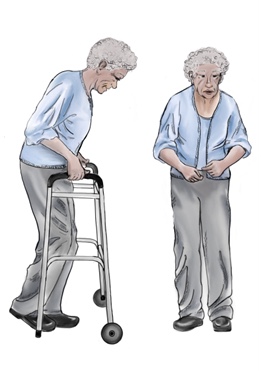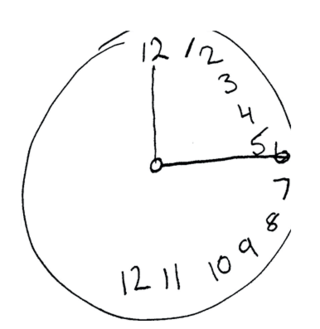
In neuroscience and psychology, the term language center refers collectively to the areas of the brain which serve a particular function for speech processing and production. Language is a core system that gives humans the capacity to solve difficult problems and provides them with a unique type of social interaction. Language allows individuals to attribute symbols to specific concepts, and utilize them through sentences and phrases that follow proper grammatical rules. Finally, speech is the mechanism by which language is orally expressed.

Parkinsonism is a clinical syndrome characterized by tremor, bradykinesia, rigidity, and postural instability. Both hypokinetic as well as hyperkinetic features are displayed by Parkinsonism.These are the four motor symptoms found in Parkinson's disease (PD) – after which it is named – dementia with Lewy bodies (DLB), Parkinson's disease dementia (PDD), and many other conditions. This set of symptoms occurs in a wide range of conditions and may have many causes, including neurodegenerative conditions, drugs, toxins, metabolic diseases, and neurological conditions other than PD.
Speech disorders, impairments, or impediments, are a type of communication disorder in which normal speech is disrupted. This can mean fluency disorders like stuttering, cluttering or lisps. Someone who is unable to speak due to a speech disorder is considered mute. Speech skills are vital to social relationships and learning, and delays or disorders that relate to developing these skills can impact individuals function. For many children and adolescents, this can present as issues with academics. Speech disorders affect roughly 11.5% of the US population, and 5% of the primary school population. Speech is a complex process that requires precise timing, nerve and muscle control, and as a result is susceptible to impairments. A person who has a stroke, an accident or birth defect may have speech and language problems.
Dysarthria is a speech sound disorder resulting from neurological injury of the motor component of the motor–speech system and is characterized by poor articulation of phonemes. In other words, it is a condition in which problems effectively occur with the muscles that help produce speech, often making it very difficult to pronounce words. It is unrelated to problems with understanding language, although a person can have both. Any of the speech subsystems can be affected, leading to impairments in intelligibility, audibility, naturalness, and efficiency of vocal communication. Dysarthria that has progressed to a total loss of speech is referred to as anarthria. The term dysarthria was formed from the Greek components dys- "dysfunctional, impaired" and arthr- "joint, vocal articulation".
Specific language impairment (SLI) is diagnosed when a child's language does not develop normally and the difficulties cannot be accounted for by generally slow development, physical abnormality of the speech apparatus, autism spectrum disorder, apraxia, acquired brain damage or hearing loss. Twin studies have shown that it is under genetic influence. Although language impairment can result from a single-gene mutation, this is unusual. More commonly SLI results from the combined influence of multiple genetic variants, each of which is found in the general population, as well as environmental influences.

Speech–language pathology (also known as speech and language pathology or logopedics) is a healthcare and academic discipline concerning the evaluation, treatment, and prevention of communication disorders, including expressive and mixed receptive-expressive language disorders, voice disorders, speech sound disorders, speech disfluency, pragmatic language impairments, and social communication difficulties, as well as swallowing disorders across the lifespan. It is an allied health profession regulated by professional bodies including the American Speech-Language-Hearing Association (ASHA) and Speech Pathology Australia. The field of speech-language pathology is practiced by a clinician known as a speech-language pathologist (SLP) or a speech and language therapist (SLT). SLPs also play an important role in the screening, diagnosis, and treatment of autism spectrum disorder (ASD), often in collaboration with pediatricians and psychologists.
Dysprosody, which may manifest as pseudo-foreign accent syndrome, refers to a disorder in which one or more of the prosodic functions are either compromised or eliminated.
In human development, muteness or mutism is defined as an absence of speech, with or without an ability to hear the speech of others. Mutism is typically understood as a person's inability to speak, and commonly observed by their family members, caregivers, teachers, doctors or speech and language pathologists. It may not be a permanent condition, as muteness can be caused or manifest due to several different phenomena, such as physiological injury, illness, medical side effects, psychological trauma, developmental disorders, or neurological disorders. A specific physical disability or communication disorder can be more easily diagnosed. Loss of previously normal speech (aphasia) can be due to accidents, disease, or surgical complication; it is rarely for psychological reasons.

Parkinson's disease (PD), or simply Parkinson's, is a long-term neurodegenerative disease of mainly the central nervous system that affects both the motor system and non-motor systems. The symptoms usually emerge slowly, and as the disease progresses, non-motor symptoms become more common. Usual symptoms are tremor, slowness of movement, rigidity, and difficulty with balance, collectively known as parkinsonism. Parkinson's disease dementia, falls and neuropsychiatric problems such as sleep abnormalities, psychosis, mood swings, or behavioral changes may arise in advanced stages.

Signs and symptoms of Parkinson's disease are varied. Parkinson's disease affects movement, producing motor symptoms. Non-motor symptoms, which include dysautonomia, cognitive and neurobehavioral problems, and sensory and sleep difficulties, are also common. When other diseases mimic Parkinson's disease, they are categorized as parkinsonism.

The Montreal Cognitive Assessment (MoCA) is a widely used screening assessment for detecting cognitive impairment. It was created in 1996 by Ziad Nasreddine in Montreal, Quebec. It was validated in the setting of mild cognitive impairment (MCI), and has subsequently been adopted in numerous other clinical settings. This test consists of 30 points and takes 10 minutes for the individual to complete. The original English version is performed in seven steps, which may change in some countries dependent on education and culture. The basics of this test include short-term memory, executive function, attention, focus, and more.
In psychiatry, stilted speech or pedantic speech is communication characterized by situationally inappropriate formality. This formality can be expressed both through abnormal prosody as well as speech content that is "inappropriately pompous, legalistic, philosophical, or quaint". Often, such speech can act as evidence for autism spectrum disorder (ASD) or a thought disorder, a common symptom in schizophrenia or schizoid personality disorder.
The temporal dynamics of music and language describes how the brain coordinates its different regions to process musical and vocal sounds. Both music and language feature rhythmic and melodic structure. Both employ a finite set of basic elements that are combined in ordered ways to create complete musical or lingual ideas.
The neuroscience of aging is the study of the changes in the nervous system that occur with ageing. Aging is associated with many changes in the central nervous system, such as mild atrophy of the cortex that is considered non-pathological. Aging is also associated with many neurological and neurodegenerative disease such as amyotrophic lateral sclerosis, dementia, mild cognitive impairment, Parkinson's disease, and Creutzfeldt–Jakob disease.
Susan Ellis Weismer is a language and communication scientist known for her work on language development in children with specific language impairment and autism spectrum disorder (ASD). She is the Oros Family Chair and Professor of Communication Sciences and Disorders at the University of Wisconsin–Madison, where she is a Principal Investigator and Director of the Language Processes Lab. She has also served as the Associate Dean for Research, College of Letters and Sciences at the University of Wisconsin–Madison.
Nicola Botting is a language and communication scientist whose work focuses on language and psychological outcomes of children with low birth weight, autism spectrum disorder, developmental language disorder, and other developmental disabilities. She is Professor of Developmental Disorders, Language & Communication Science at the City University of London. Botting is editor-in-chief of the journal Autism & Developmental Language Impairments.
Jennifer Bohun Hay is a New Zealand linguist who specialises in sociolinguistics, laboratory phonology, and the history of New Zealand English. As of 2020 she is a full professor at the University of Canterbury.

Bronwen Jane Connor is a New Zealand academic. She is a professor of pharmacology at the University of Auckland, where she is head of the Neural Reprogramming and Repair Lab.
Stephanie Margaret Hughes is a New Zealand molecular neurobiologist, and is a full professor at the University of Otago, specialising in gene therapy for the fatal childhood disorders known as Batten disease.
Catherine Ann Moran is a Canadian–New Zealand academic, and is a full professor at the University of Canterbury, specialising in memory and cognition, and language learning. She is especially interested in how head injuries affected the development and processing of language.






